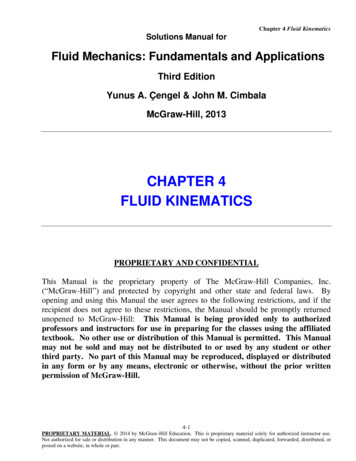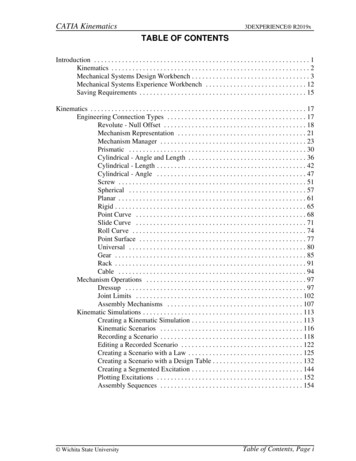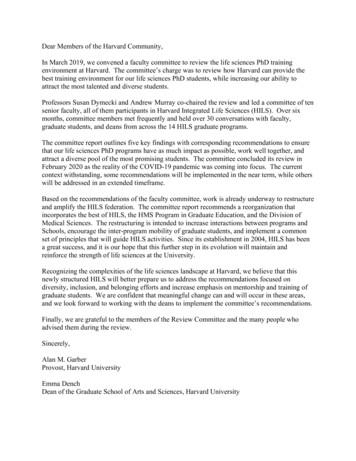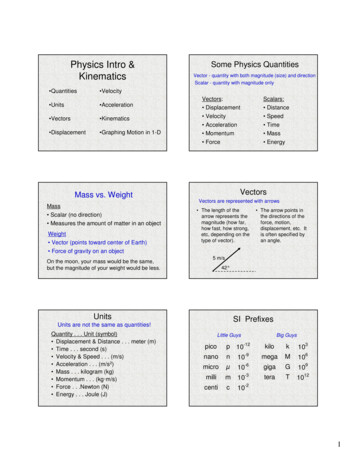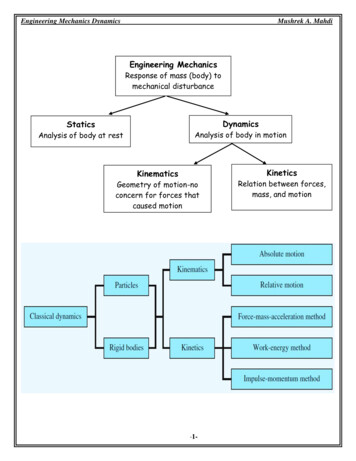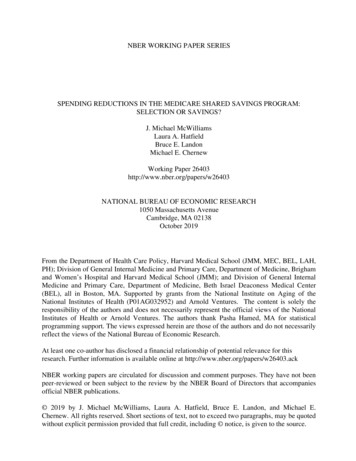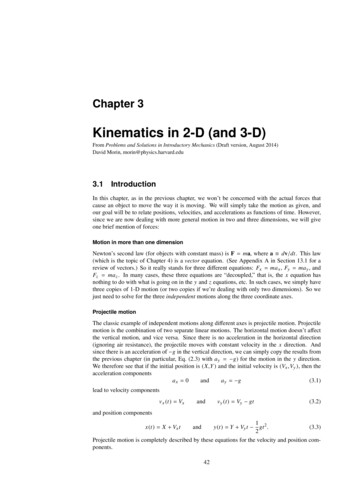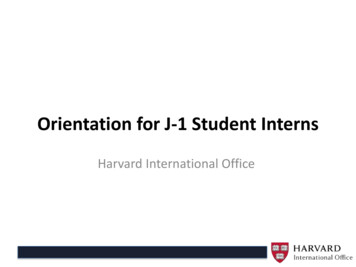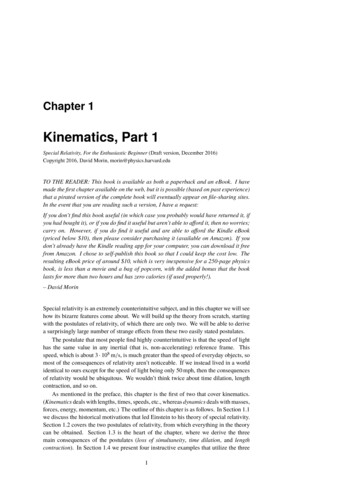
Transcription
Chapter 1Kinematics, Part 1Special Relativity, For the Enthusiastic Beginner (Draft version, December 2016)Copyright 2016, David Morin, morin@physics.harvard.eduTO THE READER: This book is available as both a paperback and an eBook. I havemade the first chapter available on the web, but it is possible (based on past experience)that a pirated version of the complete book will eventually appear on file-sharing sites.In the event that you are reading such a version, I have a request:If you don’t find this book useful (in which case you probably would have returned it, ifyou had bought it), or if you do find it useful but aren’t able to afford it, then no worries;carry on. However, if you do find it useful and are able to afford the Kindle eBook(priced below 10), then please consider purchasing it (available on Amazon). If youdon’t already have the Kindle reading app for your computer, you can download it freefrom Amazon. I chose to self-publish this book so that I could keep the cost low. Theresulting eBook price of around 10, which is very inexpensive for a 250-page physicsbook, is less than a movie and a bag of popcorn, with the added bonus that the booklasts for more than two hours and has zero calories (if used properly!).– David MorinSpecial relativity is an extremely counterintuitive subject, and in this chapter we will seehow its bizarre features come about. We will build up the theory from scratch, startingwith the postulates of relativity, of which there are only two. We will be able to derivea surprisingly large number of strange effects from these two easily stated postulates.The postulate that most people find highly counterintuitive is that the speed of lighthas the same value in any inertial (that is, non-accelerating) reference frame. Thisspeed, which is about 3 · 108 m/s, is much greater than the speed of everyday objects, somost of the consequences of relativity aren’t noticeable. If we instead lived in a worldidentical to ours except for the speed of light being only 50 mph, then the consequencesof relativity would be ubiquitous. We wouldn’t think twice about time dilation, lengthcontraction, and so on.As mentioned in the preface, this chapter is the first of two that cover kinematics.(Kinematics deals with lengths, times, speeds, etc., whereas dynamics deals with masses,forces, energy, momentum, etc.) The outline of this chapter is as follows. In Section 1.1we discuss the historical motivations that led Einstein to his theory of special relativity.Section 1.2 covers the two postulates of relativity, from which everything in the theorycan be obtained. Section 1.3 is the heart of the chapter, where we derive the threemain consequences of the postulates (loss of simultaneity, time dilation, and lengthcontraction). In Section 1.4 we present four instructive examples that utilize the three1
2Chapter 1. Kinematics, Part 1fundamental effects. Section 1.5 covers the velocity-addition formula, which givesthe proper correction to the naive Newtonian result (simply adding the velocities). InChapter 2 we will continue our discussion of kinematics, covering more advanced topics.1.1 MotivationAlthough it was certainly a stroke of genius that led Einstein to his theory of relativity,it didn’t just come out of the blue. A number of conundrums in 19th-century physicssuggested that something was amiss. Many people had made efforts to explain awaythese conundrums, and at least a few steps had been taken toward the correct theory.But Einstein was the one who finally put everything together, and he did so in a way thathad consequences far beyond the realm of the specific issues that people were tryingto understand. Indeed, his theory turned our idea of space and time on its head. Butbefore we get to the heart of the theory, let’s look at two of the major problems in late19th-century physics. (A third issue, involving the addition of velocities, is presented inProblem 1.15.) If you can’t wait to get to the postulates (and subsequently the results) ofspecial relativity, you can go straight to Section 1.2. The present section can be skippedon a first reading.1.1.1 Galilean transformations, Maxwell’s equationsy'yvxzSx'S'z'(ground)(train)Figure 1.1Imagine standing on the ground and watching a train travel by with constant speed v inthe x direction. Let the reference frame of the ground be labeled S, and let the referenceframe of the train be labeled S ′, as shown in Fig. 1.1. Consider two events that happenon the train. An event is defined as something that occurs with definite space and timecoordinates (as measured in a given frame). For example, a person might clap herhands; this clap takes place at a definite time and a definite location. Technically, theclap lasts for a nonzero time (a few hundredths of a second), and the hands extend over anonzero distance (a few inches). But we’ll ignore these issues and assume that the clapcan be described be unique x, y, z, and t values. Note that a given event isn’t associatedwith one particular frame. The event simply happens, independent of a frame. For anyarbitrary frame we then choose to consider, we can describe the event by specifying thecoordinates as measured in that frame.On our train, the two events might be one person clapping her hands and anotherperson stomping his feet. If the space and time separations between these two eventsin the frame of the train are x ′ and t ′, what are the space and time separations, xand t, in the frame of the ground? Ignoring what we’ll be learning about relativity inthis chapter, the answers are “obvious” (although, as we’ll see in Section 2.1 when wederive the Lorentz transformations, obvious things can apparently be incorrect!). Thetime separation t is “clearly” the same as on the train, so we have t t ′. We knowfrom everyday experience that nothing strange happens with time. When you see peopleexiting a train station, they’re not fiddling with their watches, trying to recalibrate themwith a ground-based clock.The spatial separation is a little more interesting, but still fairly simple. If the trainweren’t moving, then we would just have x x ′. This is true because if the trainisn’t moving, then the only possible difference between the frames is the location ofthe origin. But the only consequence of this difference is that every x ′ coordinate inthe train is equal to a given fixed number plus the corresponding x coordinate on theground. This fixed number then cancels when calculating the separation, x ′ x 2′ x 1′ .However, in the general case where the train is moving, everything in the train getscarried along at speed v during the time t (which equals t ′) between the two events.
1.1. Motivation3So as seen in the ground frame, the person stomping his feet ends up v t ′ to the right (orleft, if v is negative) of where he would be if the train weren’t moving. The total spatialseparation x between the events in the ground frame is therefore the x ′ separationthat would arise if the train weren’t moving, plus the v t ′ separation due to the motionof the train. That is, x x ′ v t ′, as shown in Fig. 1.2.y(ground)(train start)y'vzvEvent 1xS(train end)y'Event 2x'z'S'x'S'z'v t' x' xFigure 1.2The Galilean transformations (first written down by Galileo Galilei in 1638) are therefore x x ′ v t ′ t t ′(1.1)Nothing interesting happens in the y and z directions (assuming the train is travelingin the x direction), so we additionally have y y ′ and z z ′. Both of thesecommon values are zero for the events in Fig. 1.2, because the events occur on the xaxis. But for general locations of the events, the ’s will be nonzero.A special case of Eq. (1.1) arises when the two events occur at the same place onthe train, so that x ′ 0. In this case we have x v t ′. This makes sense, becausethe spot on the train where the events occur simply travels a distance v t (which equalsv t ′) by the time the second event occurs.The principle of Galilean invariance says that the laws of physics are invariant underthe above Galilean transformations. Alternatively, it says that the laws of physics holdin all inertial (non-accelerating) frames. (It was assumed prior to Einstein that thesetwo statements say the same thing, but we will soon see that they do not. The secondstatement is the one that remains valid in relativity.) This principle is quite believable.For example, in Galilean (nonrelativistic) physics, Newton’s second law, F ma (orreally F dp/dt) holds in all inertial frames, because (1) the force F is the same in allinertial frames, and (2) the constant relative velocity vrel between any two inertial framesimplies that the acceleration of a given particle is the same in all inertial frames. Writtenout explicitly, the velocities v1 and v2 in the two frames are related by v1 v2 vrel , soa1 dv1d(v2 vrel ) dv2 0 a2,dt 1dt 1dt 2(1.2)where we have used the facts that t 1 t 2 (at least in a Galilean world) and that thederivative of a constant is zero.Remarks:1. Note that the Galilean transformations in Eq. (1.1) aren’t symmetric in x and t. This isn’tnecessarily a bad thing, but it turns out that it will in fact be a problem in special relativity,where space and time are treated on a more equal footing. We’ll find in Section 2.1 that theGalilean transformations are replaced by the Lorentz transformations, and the latter are infact symmetric in x and t (up to factors of the speed of light, c).
4Chapter 1. Kinematics, Part 12. Eq. (1.1) deals only with the differences in the x and t values between two events, and notwith the values of the coordinates themselves of each event. The values of the coordinatesof a single event depend on where you pick your origin, which is an arbitrary choice. Thecoordinate differences between two events, however, are independent of this choice, andthis allows us to make the physically meaningful statements in Eq. (1.1). Since it makesno sense for a physical result to depend on your arbitrary choice of origin, the Lorentztransformations we derive in Section 2.1 will also need to involve only differences incoordinates.3. We’ve been talking a lot about “events,” so just to make sure we’re on the same page withthe definition of an event, we should give some examples of things that are not events. If atrain is at rest on the ground (or even if it is moving), and if you look at it at a snapshot intime, then this doesn’t describe an event, because the train has spatial extent. There isn’t aunique spatial coordinate that describes the train. If you instead consider a specific pointon the train at the given instant, then that does describe an event. As another example ofa non event, if you look at a pebble on the ground for a minute, then this doesn’t describean event, because you haven’t specified the time coordinate. If you instead consider thepebble at a particular instant in time, then that does describe an event. (We’ll consider thepebble to be a point object, so that the spatial coordinate is unique.) We introduced the Galilean transformations above because of their relation (moreprecisely, their conflict) with Maxwell’s equations. One of the great triumphs of 19thcentury physics was the theory of electromagnetism. In 1864, James Clerk Maxwellwrote down a set of equations that collectively described everything that was knownabout the subject. These equations involve the electric and magnetic fields through theirspace and time derivatives. Maxwell’s original formulation consisted of a large numberof equations, but these were later written more compactly, using vector calculus, asfour equations. We won’t worry about their specific form here, but it turns out thatif you transform the equations from one reference frame to another via the Galileantransformations, they end up taking a different form. That is, if you’ve written downMaxwell’s equations in one frame (where they take their standard nice-looking form),and if you then replace the coordinates in this frame by those in another frame, usingEq. (1.1), then the equations look different (and not so nice).This different appearance presents a major problem. If Maxwell’s equations take anice form in one frame and a not-so-nice form in every other frame, then why is oneframe special? Said in another way, it can be shown that Maxwell’s equations implythat light moves with a certain speed c. But which frame is this speed measured withrespect to? The Galilean transformations imply that if the speed is c with respect to agiven frame, then it is not c with respect to any other frame. (You need to add or subtractthe relative speed v between the frames.) The proposed special frame where Maxwell’sequations are nice and the speed of light is c was called the frame of the ether. We’lltalk in detail about the ether in the next subsection, but experiments showed that lightwas surprisingly always measured to move with speed c in every frame, no matter whichway the frame was moving through the supposed ether. We say “supposed” because thefinal conclusion was that the ether simply doesn’t exist.There were thus various possibilities. Something was wrong with either Maxwell’sequations, the Galilean transformations, or the way in which measurements of speedwere done (see Footnote 2 on page 8). Considering how “obvious” the Galilean transformations are, the natural assumption in the late 19th century was that the problem layelsewhere. However, after a good deal of effort by many people to make everythingelse fit with the Galilean transformations, Einstein finally showed that these were infact the culprit. It was well known that Maxwell’s equations were invariant under theLorentz transformations (in contrast with their non-invariance under the Galilean ones),
1.1. Motivation5but Einstein was the first to recognize the full meaning of these transformations. Insteadof being relevant only to electromagnetism, the Lorentz transformations replaced theGalilean ones universally.More precisely, in 1905 Einstein showed why the Galilean transformations are simplya special case of the Lorentz transformations, valid (to a high degree of accuracy) onlywhen the speed involved is much less than the speed of light. As we’ll see in Section 2.1,the coefficients in the Lorentz transformations depend on both the relative speed v ofthe frames and the speed of light c, where the c’s appear in various denominators. Sincec is quite large (about 3 · 108 m/s) compared with everyday speeds v, the parts of theLorentz transformations involving c are negligible, for any typical v. The survivingterms are the ones in the Galilean transformations in Eq. (1.1). These are the only termsthat are noticeable for everyday speeds. This is why no one prior to Einstein realizedthat the correct transformations between two frames had anything to do with the speedof light.As he pondered the long futile fightTo make Galileo’s world right,In a new variationOf the old transformation,It was Einstein who first saw the light.In short, the reasons why Maxwell’s equations are in conflict with the Galileantransformations are: (1) The speed of light is what determines the scale at which theGalilean transformations break down, (2) Maxwell’s equations inherently involve thespeed of light, because light is an electromagnetic wave.1.1.2 Michelson–Morley experimentAs mentioned above, it was known in the late 19th century, after Maxwell wrote downhis equations, that light is an electromagnetic wave and that it moves with a speed ofabout 3 · 108 m/s.1 Now, every other wave that people knew about at the time neededa medium to propagate in. Sound waves need air, ocean waves of course need water,waves on a string of course need the string, and so on. It was therefore natural to assumethat light also needed a medium to propagate in. This proposed medium was called theether.However, if light propagates in a given medium, and if the speed in this medium isc, then the speed in a reference frame moving relative to the medium should be differentfrom c. Consider, for example, sound waves in air. If the speed of sound in air is vsound ,and if you run toward a sound source with speed vyou , then the speed of the sound waveswith respect to you (assuming it’s a windless day) is vsound vyou . Equivalently, if youare standing at rest downwind and the speed of the wind is vwind , then the speed of thesound waves with respect to you is vsound vwind .Assuming that the ether really exists (although we’ll soon see that it doesn’t), areasonable thing to do is to try to measure one’s speed with respect to it. This can bedone as follows. We’ll frame this discussion in terms of sound waves in air. Let vs bethe speed of sound in air. Imagine two people standing on the ends of a long platformof length L that moves at speed vp with respect to the reference frame in which the airis at rest. One person claps, the other person claps immediately when he hears the firstclap (assume that the reaction time is negligible), and then the first person records the1The exact value of the speed is 299,792,458 m/s. A meter is actually defined to be 1/299,792,458 of thedistance that light travels in one second in vacuum. So this speed of light is exact. There is no need for anerror bar because there is no measurement uncertainty.
6Chapter 1. Kinematics, Part 1total time elapsed when she hears the second clap. What is this total time? Well, wecan’t actually give an answer without knowing which direction the platform is moving.Is it moving parallel to its length, or perpendicular to it (or somewhere in between)?Let’s look at these two basic cases. For both of these, we’ll view the setup and do thecalculation in the frame in which the air is at rest.LvsvpFigure 1.3 Parallel motion: Consider first the case where the platform moves parallel toits length. In the reference frame of the air, assume that the person at the rear isthe one who claps first; see Fig. 1.3. Then if vs is the speed of sound and vp is thespeed of the platform, it takes a time of L/(vs vp ) for the sound from the firstclap to travel forward to the front person. This is true because the sound closesthe initial gap of L at a relative speed of vs vp , as viewed in the frame of theair. (Alternatively, relative to the initial position of the back of the platform, theposition of the sound wave is vs t, and the position of the front person is L vp t.Equating these gives t L/(vs vp ).) This time is longer than the naive answer ofL/vs because the front person is moving away from the rear person, which meansthat the sound has to travel farther than L.By similar reasoning, the time for the sound from the second clap to travelbackward to the rear person is L/(vs vp ). This time is shorter than the naiveanswer of L/vs because the rear person is moving toward the front person, whichmeans that the sound travels less than L.Adding the forward and backward times gives a total time oft1 LL2Lvs .vs vp vs vp vs2 vp2(1.3)This correctly equals 2L/vs when vp 0. In this case the platform is at rest, sothe sound simply needs to travel forward and backward a total distance of 2L atspeed vp . And the result correctly equals infinity when vp vs . In this case thefront person is receding as fast as the sound is traveling, so the sound from thefirst clap can never catch up.vpvsLvsplatformvpvpFigure 1.4 Perpendicular motion: Now consider the case where the platform movesperpendicular to its length. In the reference frame of the air, we have the situationshown in Fig. 1.4. The sound moves diagonally with speed vs . (The sound actuallymoves in all directions, of course, but it’s only the part of the sound wave thatmoves in a particular diagonal direction that ends up hitting the other person.)Since the “horizontal” component of the diagonal velocity is the platform’sspeed vp , the Pythagorean theorem gives the “vertical” component as vs2 vp2 , asshown in Fig. 1.5. This is the speed at which the length L of the platform istraversed during both the out and back parts of the trip. So the total time ist2 vsvs2 - vp2vpFigure 1.52Lvs2 vp2.(1.4)Again, this correctly equals 2L/vs when vp 0, and infinity when vp vs . Thevertical component of the velocity is zero in the latter case, because the diagonalpath is essentially horizontal.The times in Eqs. (1.3) and (1.4) are not equal; you can quickly show that t 1 t 2 .It turns out that (for given values of vs and vp ) of all the possible orientations of theplatform relative to the direction of motion (which we have been taking to be rightward),the t 1 in Eq. (1.3) is the largest possible time, and the t 2 in Eq. (1.4) is the smallest.
1.1. Motivation7(The proof of this is somewhat tedious, but at least it is believable that if the platform isoriented between the above two special cases, the time lies between the associated timest 1 and t 2 .) Therefore, if you are on a large surface that is moving with respect to the air,and if you know the value of vs , then if you want to figure out what vp is, all you haveto do is repeat the above experiment with someone standing at various points along thecircumference of a given circle of radius L around you. (Assume that it doesn’t occur toyou to toss a little piece of paper in the air, in order to at least determine the direction ofthe wind with respect to you.) If you take the largest total time observed and equate itwith t 1 , then Eq. (1.3) will give you vp . Alternatively, you can equate the smallest totaltime with t 2 , and Eq. (1.4) will yield the same vp .In the limiting case where vp vs , we can make some approximations to the aboveexpressions for t 1 and t 2 . These approximations involve the Taylor-series expressions1/(1 ϵ ) 1 ϵ and 1/ 1 ϵ 1 ϵ/2. (See Appendix G for a discussion of Taylorseries.) These expressions yield the following approximate result for the differencebetween t 1 and t 2 (after first rewriting t 1 and t 2 so that a “1” appears in the denominator): /*.11 /.221 vp /vs1 vp2 /vs2 ,() ()vp2vp22L * 1 2 1 2 vs ,vs2vs 2Lvp 3 .vs t t 1 t 2 2Lvs(1.5)The difference t 1 t 2 is what we’ll be concerned with in the Michelson–Morley experiment, which we will now discuss.The strategy in the above sound-in-air setup is the basic idea behind Michelson’sand Morley’s attempt in 1887 to measure the speed of the earth through the supposedether. (See Handschy (1982) for the data and analysis of the experiment.) There is,however, a major complication with light that doesn’t arise with sound. The speed oflight is so large that any time intervals that are individually measured will inevitably havemeasurement errors that are far larger than the difference between t 1 and t 2 . Therefore,individual time measurements give essentially no information. Fortunately, there is away out of this impasse. The trick is to measure t 1 and t 2 concurrently, as opposed toseparately. More precisely, the trick is to measure only the difference t 1 t 2 , and notthe individual values t 1 and t 2 . This can be done as follows.Consider two of the above “platform” scenarios arranged at right angles with respect to each other, with the same starting point. This can be arranged by having a(monochromatic) light beam encounter a beam splitter that sends two beams off at 90 angles. The beams then hit mirrors and bounce back to the beam splitter where they(partially) recombine before hitting a screen; see Fig. 1.6. The fact that light is a wave,which is what got us into this ether mess in the first place, is now what saves the day. Thewave nature of light implies that the recombined light beam produces an interferencepattern on the screen. At the center of the pattern, the beams will constructively ordestructively interfere (or something in between), depending on whether the two lightbeams are in phase or out of phase when they recombine. This interference patternis extremely delicate. The slightest change in travel times of the beams will cause thepattern to noticeably shift. This type of device, which measures the interference betweentwo light beams, is known as an interferometer.If the whole apparatus is rotated around, so that the experiment is performed atvarious angles, then the maximum amount that the interference pattern changes can enFigure 1.6
8Chapter 1. Kinematics, Part 1used to determine the speed of the earth through the ether (vp in the platform setupabove). In one extreme case, the time in a given arm is longer than the time in the otherarm by Lv 2 /c3 . (We have changed notation in Eq. (1.5) so that vp v is the speed ofthe earth through the supposed ether, and vs c is the speed of light.) But in the otherextreme case, the time in the given arm is shorter by Lv 2 /c3 . So the maximum shift inthe interference pattern corresponds to a time difference of 2Lv 2 /c3 .However, when Michelson and Morley performed their experiment, they observedno interference shift as the apparatus was rotated around. Their setup did in fact allowenough precision to measure a nontrivial earth speed through the ether, if such a speedexisted. So if the ether did exist, their results implied that the speed of the earth throughit was zero. This result, although improbable, was technically fine. It might simplyhave been the case that they happened to do their experiment when the relative speedwas zero. However, when they performed their experiment a few months later, when theearth’s motion around the sun caused it to be moving in a different direction, they stillmeasured zero speed. It wasn’t possible for both of these results to be zero (assumingthat the ether exists), without some kind of modification to the physics known at thetime.Many people over the years tried to explain this null result, but none of the explanations were satisfactory. Some led to incorrect predictions in other setups, and someseemed to work fine but were a bit ad hoc.2 The correct explanation, which followedfrom Einstein’s 1905 theory of relativity, was that the ether simply doesn’t exist.3 Inother words, light doesn’t need a medium to propagate in. It doesn’t move with respect toa certain special reference frame, but rather it moves with respect to whoever is lookingat it.The findings of Michelson–MorleyAllow us to say very surely,“If this ether is real,Then it has no appeal,And shows itself off rather poorly.”Remarks:1. We assumed above that the lengths of the two arms in the apparatus were equal. However,in practice there is no hope of constructing lengths that are equal, up to errors that aresmall compared with the wavelength of the light. But fortunately this doesn’t matter. We’reconcerned not with the difference in the travel times associated with the two arms, butrather with the difference in these differences as the apparatus is rotated around. UsingEqs. (1.3) and (1.4) with different lengths L 1 and L 2 , you can show (assuming v c)that the maximum interference shift corresponds to a time of (L 1 L 2 )v 2 /c3 . This is thegeneralization of the 2Lv 2 /c3 result we derived in Eq. (1.5) (in different notation) whenthe lengths were equal. The measurement errors in L 1 and L 2 therefore need only be smallcompared with the (macroscopic) lengths L 1 and L 2 , as opposed to small compared withthe (microscopic) wavelength of light.2. Assuming that the lengths of the arms are approximately equal, let’s plug in some roughnumbers to see how much the interference pattern shifts. The Michelson–Morley setup2The most successful explanation was the Lorentz–FitzGerald contraction. These two physicists independentlyproposed that lengths are contracted in the direction of the motion by precisely the right factor, namely 1 v 2 /c 2 , to make the travel times in the two arms of the Michelson–Morley setup equal, thus yielding thenull result. This explanation was essentially correct, although the reason why it was correct wasn’t knownuntil Einstein came along.3Although we’ve presented the Michelson–Morley experiment here for pedagogical purposes, the consensus among historians is that Einstein actually wasn’t influenced much by the experiment, except indirectlythrough Lorentz’s work on electrodynamics. See Holton (1988).
1.1. Motivation9had arms with effective lengths of about 10 m. We’ll take v to be on the order of the speedof the earth around the sun, which is about 3 · 104 m/s. We then obtain a maximal timedifference of t 2Lv 2 /c3 7 · 10 16 s. The large negative exponent here might makeus want to throw in the towel, thinking that the effect is hopelessly small. However, thedistance that light travels in the time t is ct (3 · 108 m/s)(7 · 10 16 s) 2 · 10 7 m, andthis happens to be a perfectly reasonable fraction of the wavelength of visible light, whichis around λ 6 · 10 7 m, give or take. So we have ct/λ 1/3. This maximal interferenceshift of about a third of a cycle was well within the precision of the Michelson–Morleysetup. So if the ether had really existed, Michelson and Morley definitely would have beenable to measure the speed of the earth through it.3. One proposed explanation of the observed null effect was “frame dragging.” What if theearth drags the ether along with it, thereby always yielding the observed zero relativespeed? This frame dragging is quite plausible, because in the platform example above, theplatform drags a thin layer of air along with it. And more mundanely, a car completelydrags the air in its interior along with it. But it turns out that frame dragging is inconsistentwith stellar aberration, which is the following effect.Depending on the direction of the earth’s instantaneous velocity as it obits around the sun,it is an experimental fact that a given star might (depending on its location) appear atslightly different places in the sky when viewed at two times, say, six months apart. Thisis due to the fact that a telescope must be aimed at a
from Amazon. I chose to self-publish this book so that I could keep the cost low. The resulting eBook price of around 10, which is very inexpensive for a 250-page physics book, is less than a movie and a bag of popcorn, with the added bonus that the book lasts for more than two hours and has zero calories (if used properly!). - David Morin
